Evaluation on the Long-Term Operational Reliability of Closing Springs in High-Voltage Circuit Breakers
Abstract
1. Introduction
2. Materials and Methods
2.1. Test Object
2.2. Test and Equipment
2.3. Stress Loss Rate and Failure Thresholds of the Spring
3. Degradation of Springs in the Long-Term Energy Storage State
3.1. Temperature Factor
3.2. Effect of Salt Spray Corrosion
4. Characteristics of Springs Under Long-Term Closing Operation
5. Performance Degradation Assessment and Lifetime Prediction
6. Conclusions
Author Contributions
Funding
Data Availability Statement
Conflicts of Interest
References
- Liu, Y.; Zhang, G.; Zhao, C.; Lei, S.; Qin, H.; Yang, J. Mechanical condition identification and prediction of spring operating mechanism of high voltage circuit breaker. IEEE Access 2020, 8, 210328–210338. [Google Scholar] [CrossRef]
- Jiang, J.; Lin, H.; Fang, S. Multi-Objective Optimization of a Permanent Magnet Actuator for High Voltage Vacuum Circuit Breaker Based on Adaptive Surrogate Modeling Technique. Energies 2019, 12, 4695. [Google Scholar] [CrossRef]
- Ma, H.; Qian, G.; Zhang, J.; Chen, J.; Zhou, F.; Qiu, P.; Zhang, A.; Wang, T.; Yao, X.; Liu, Z. Fatigue Life Estimation of Critical Components in a Motor-Energized Spring Operating Mechanism Based on Theory of Reliability. Energies 2024, 17, 1623. [Google Scholar] [CrossRef]
- Fu, R.; Zhao, L.; Rong, Q. Study on mechanical characteristics of operating mechanism of high voltage circuit breaker. High Volt. Appar. 2017, 53, 56–62. [Google Scholar]
- Tahvilzadeh, M.; Aliyari-Shoorehdeli, M.; Razi-Kazemi, A.A. Model-Aided Approach for Intelligent Fault Detection System for SF6 High-Voltage Circuit Breaker with Spring Operating Mechanism. IEEE Trans. Power Deliv. 2023, 38, 3356–3365. [Google Scholar]
- Sun, T. Intelligent Diagnosis Technology for Mechanical Faults of High Voltage Circuit Breakers Based on Weighted Evidence Theory. Master’s Thesis, Southeast University, Nanjing, China, 2017. [Google Scholar]
- Wang, K. Research on Evaluation Method of Performance State of Circuit Breaker Energy Storage Spring. Master’s Thesis, North China Electric Power University, Beijing, China, 2020. [Google Scholar]
- Li, X.; Wu, S.; Li, X.; Zhao, D.; Li, Q.; Li, X. Kinetic characteristics of high voltage circuit breakers based on spring stress relaxation. J. Cent. South Univ. Sci. Technol. 2019, 7, 1575–1583. [Google Scholar]
- Huang, H.; Wang, F.; Su, Y.; Lu, Y.; Xia, X. Research on detection method for abnormal state of spring operating mechanism in high voltage circuit breaker based on LMD and SVM. High Volt. Appar. 2020, 5, 243–248. [Google Scholar]
- Ding, G.; Zhu, Y.; Wu, J.; Guan, T.; Dong, H. Fatigue life analysis of key components of spring operating mechanism based on local stress-strain method. CSEE J. Power Energy Syst. 2023, 20, 8161–8170. [Google Scholar]
- Pal, U.; Mukhopadhyay, G.; Bhattacharya, S. Failure analysis of spring of hydraulic operated valve. Eng. Fail. Anal. 2019, 95, 191–198. [Google Scholar]
- GB/T 2423.17-2008; Environmental Testing for Electric and Electronic Products-Part 2: Test Method-Test Ka: Salt Mist. Standards Press of China: Beijing, China, 2009.
- Yang, C.; Gu, X.; Pan, S. Reliability evaluation of coil spring for fuse with multiple performance parameters. J. Natl. Univ. Def. Technol. 2023, 45, 200–207. [Google Scholar]
- Zhang, Y.; Liu, H.; Wang, D. (Eds.) Spring Handbook, 3rd ed.; Mechanical Industry Press: South Norwalk, CT, USA, 2017; pp. 297–333. [Google Scholar]
- Zuo, M.; Chen, Y.; Mi, Z.; Wang, Y.; Jiang, H. Effects of Cr content on corrosion behaviour and corrosion products of spring steels. J. Iron Steel Res. Int. 2019, 26, 1000–1010. [Google Scholar] [CrossRef]
- Wang, X.; Chen, Y.; Niu, G. The study on corrosion resistance of high-strength spring steel. Corros. Eng. Sci. Technol. 2018, 53, 54–64. [Google Scholar] [CrossRef]
- Huang, J. Study on Fatigue Crack Propagation Rate and Corrosion Mechanism of 60Si2Mn Spring Steel Under Salt Spray Environment. Master’s Thesis, Kunming University of Science and Technology, Kunming, China, 2023. [Google Scholar]
- Wang, K.; Shi, J.; Jin, P. Experimental analysis and application of stress relaxation characteristics of helical compression spring. Chin. J. Appl. Mech. 2021, 38, 158–165. [Google Scholar]
- Su, Y.; Xie, Z.; Wang, J.; Lu, Y.; Jiang, Z. Fatigue characteristics test and life prediction on closing spring of 12 kV vacuum circuit breaker. High Volt. Appar. 2022, 58, 165–171. [Google Scholar]
- Xu, Z.; Cheng, Y.; Weng, D.; Pan, Q.; Xie, P.; Chen, K.; Chen, S.; Lin, J.; Chen, J.; Wang, W. Research on the failure and fracture factors of spring in high voltage circuit breakers. In Proceedings of the Fourth International Conference on Mechanical Engineering, Intelligent Manufacturing, and Automation Technology (MEMAT 2023), Guilin, China, 1–3 December 2023. [Google Scholar]
- Zhang, X.; Liu, H.; Ma, S.; Yang, P. Thermal air aging and lifespan prediction of PVC-P geomembranes: An Arrhenius equation-based approach. Power Eng. Eng. Thermophys. 2023, 2, 199–211. [Google Scholar]
- Qin, Z.; Jiang, H.; Yuan, H.; Yao, J.; Zhou, B.; Nong, W.; Liu, L. Stress relaxation characteristics analysis and storage life prediction of butt separation pusher spring. In Proceedings of the 13th International Workshop of Advanced Manufacturing and Automation, Shanghai, China, 16–17 October 2023. [Google Scholar]


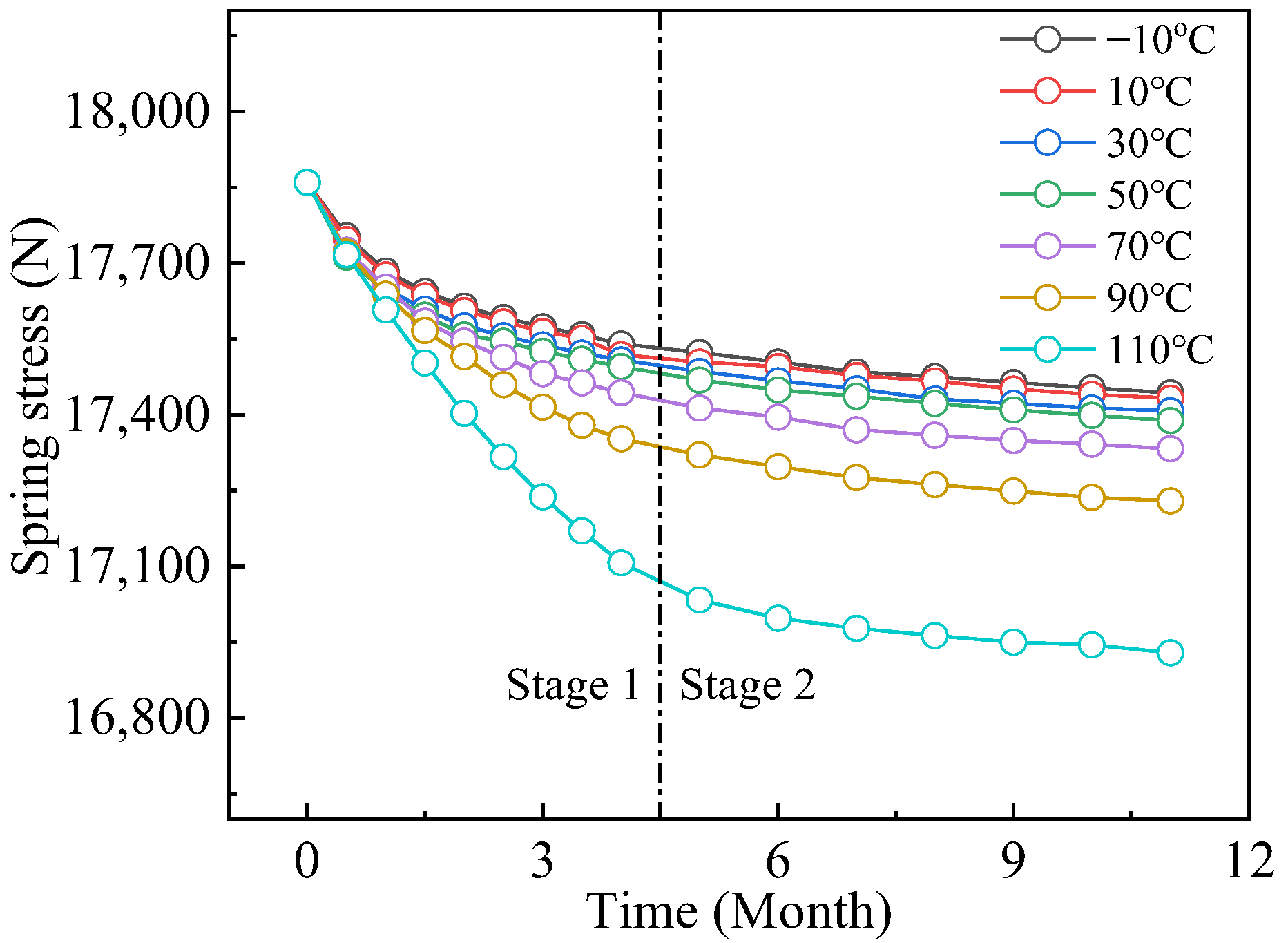
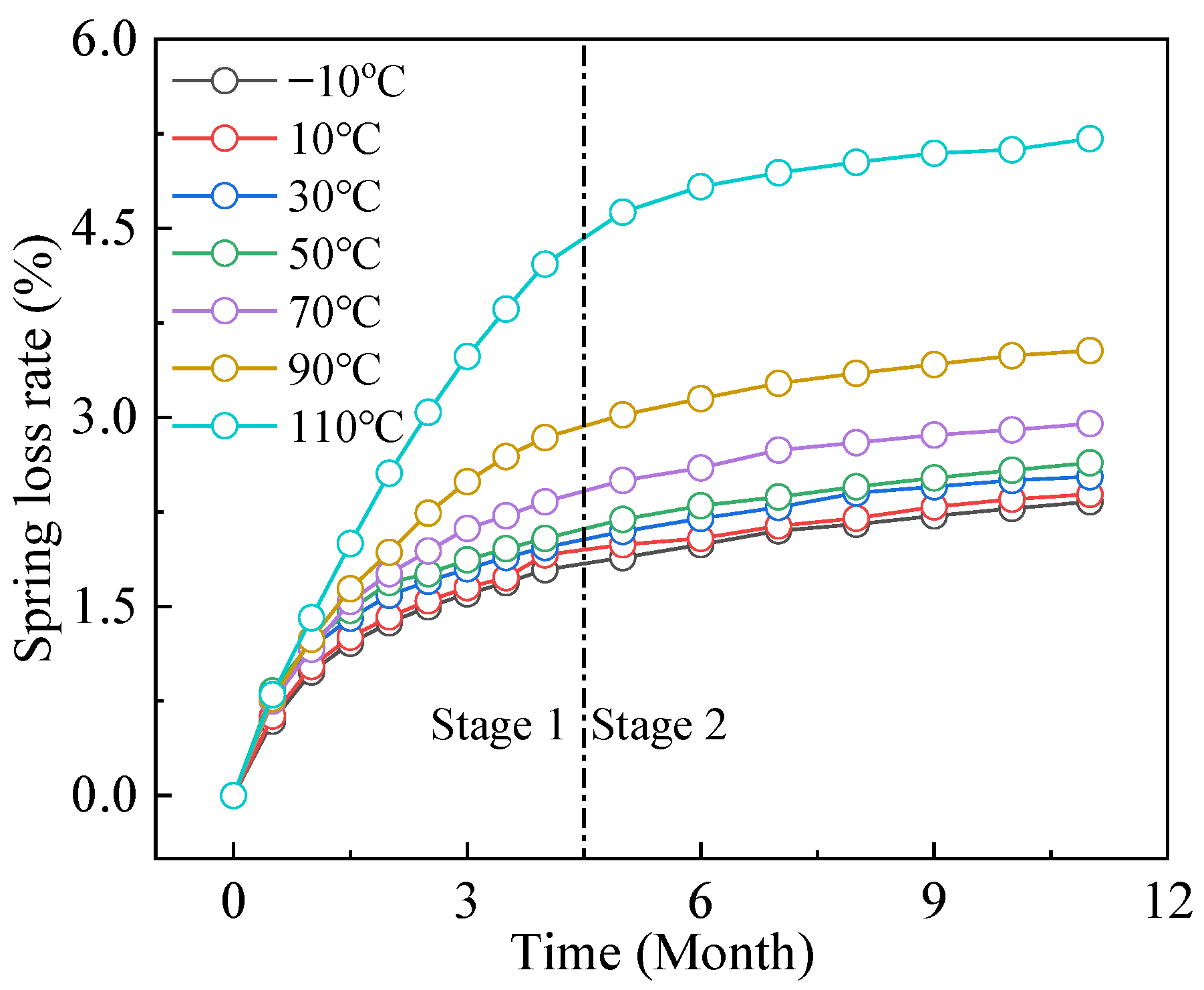
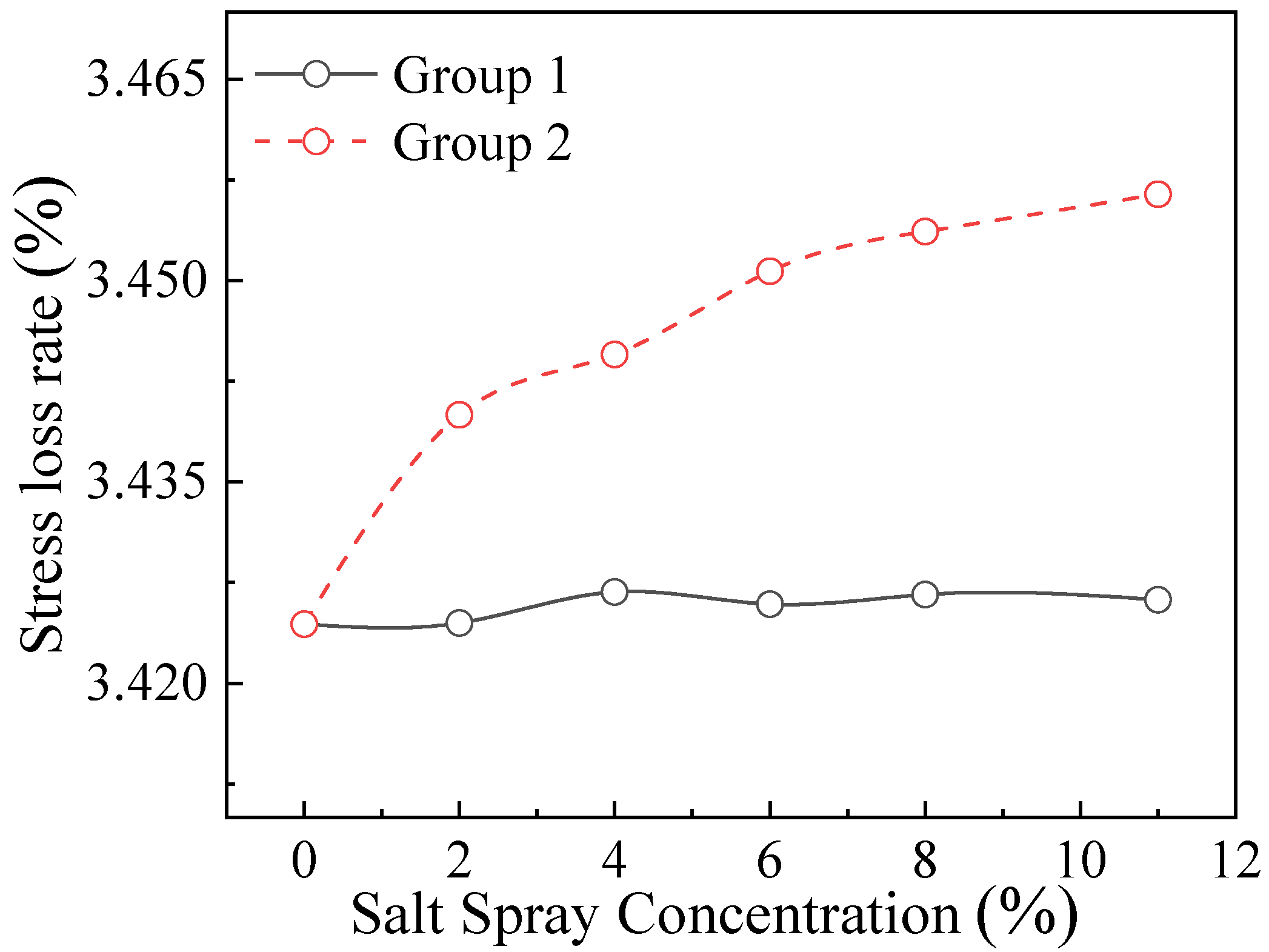


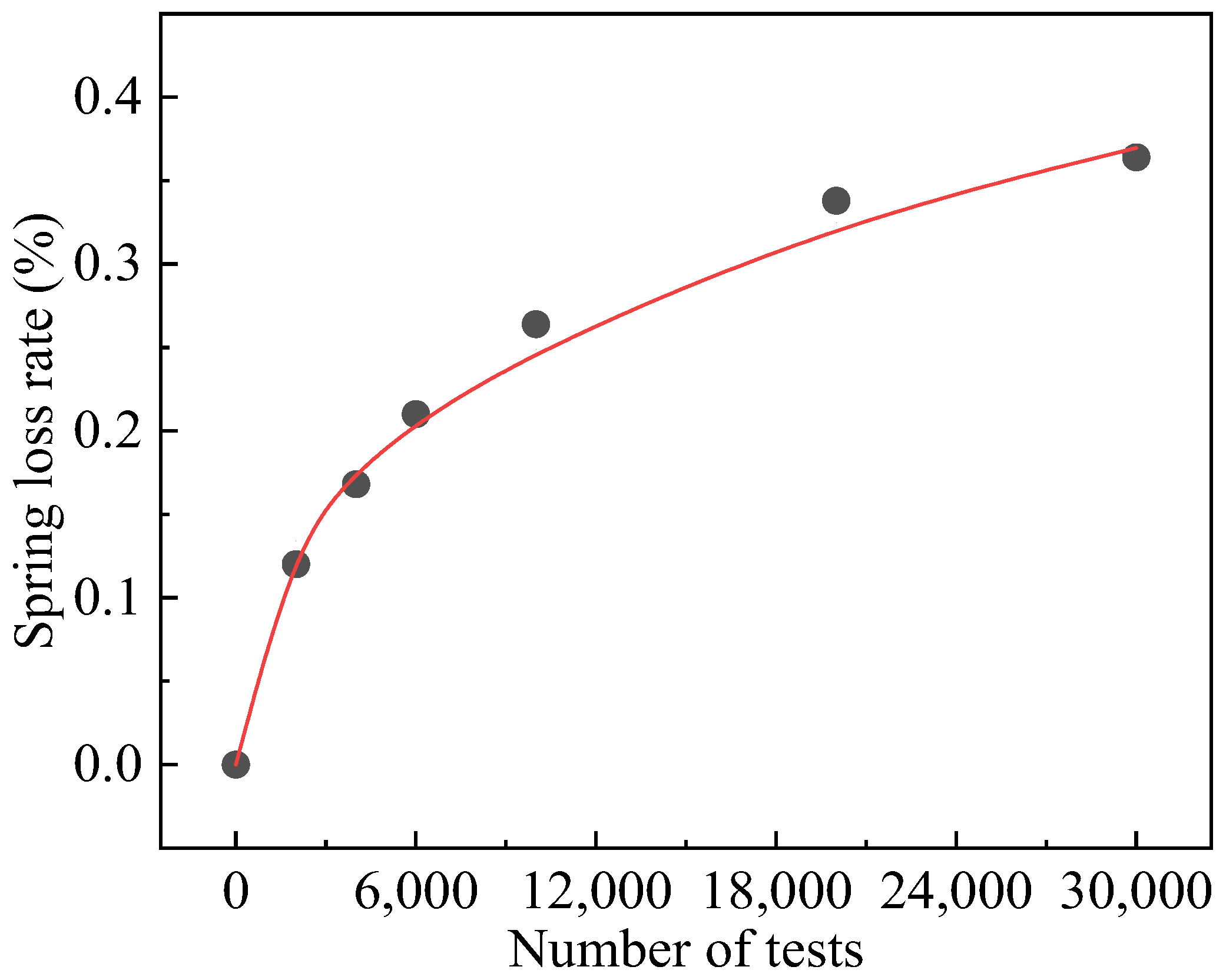
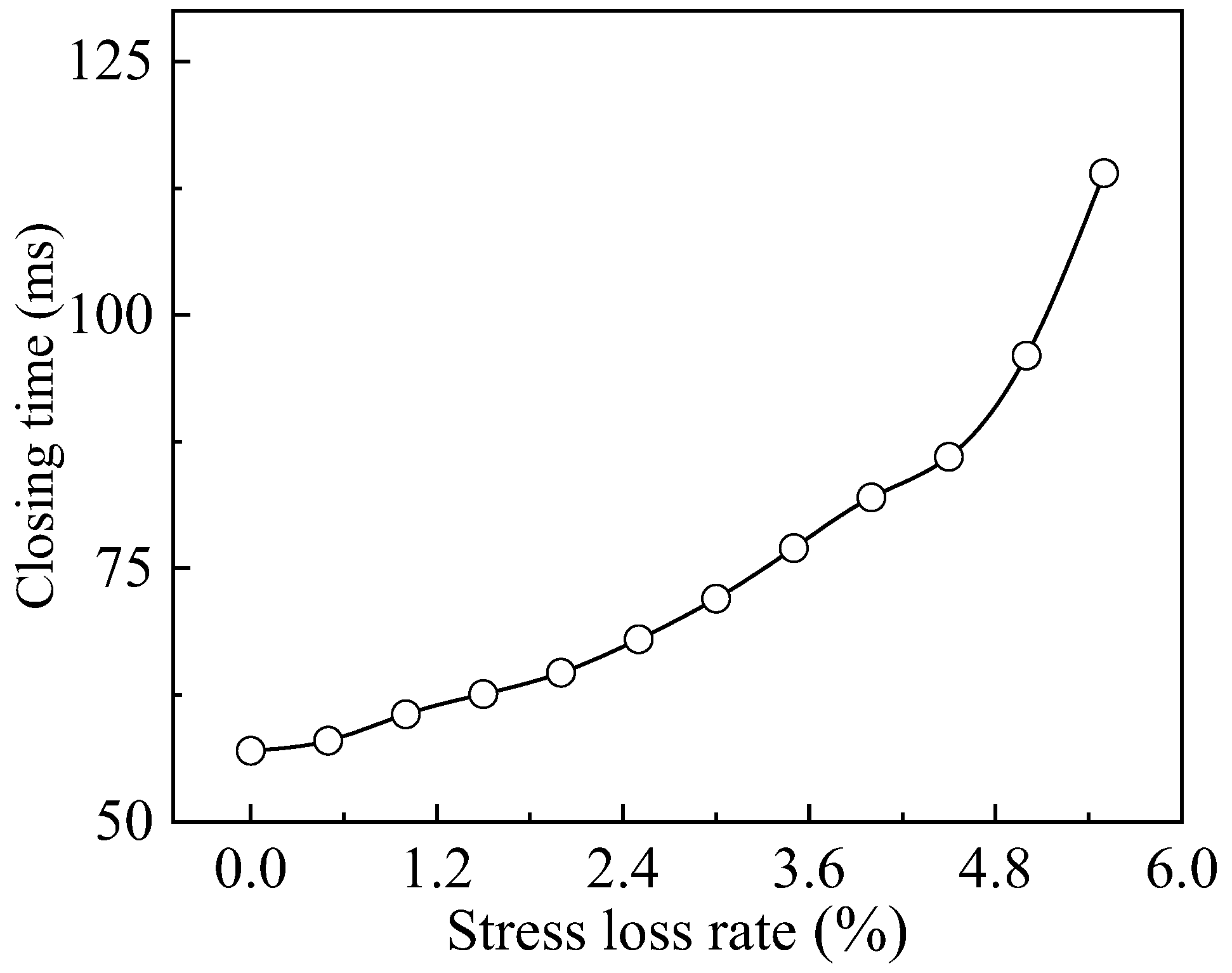

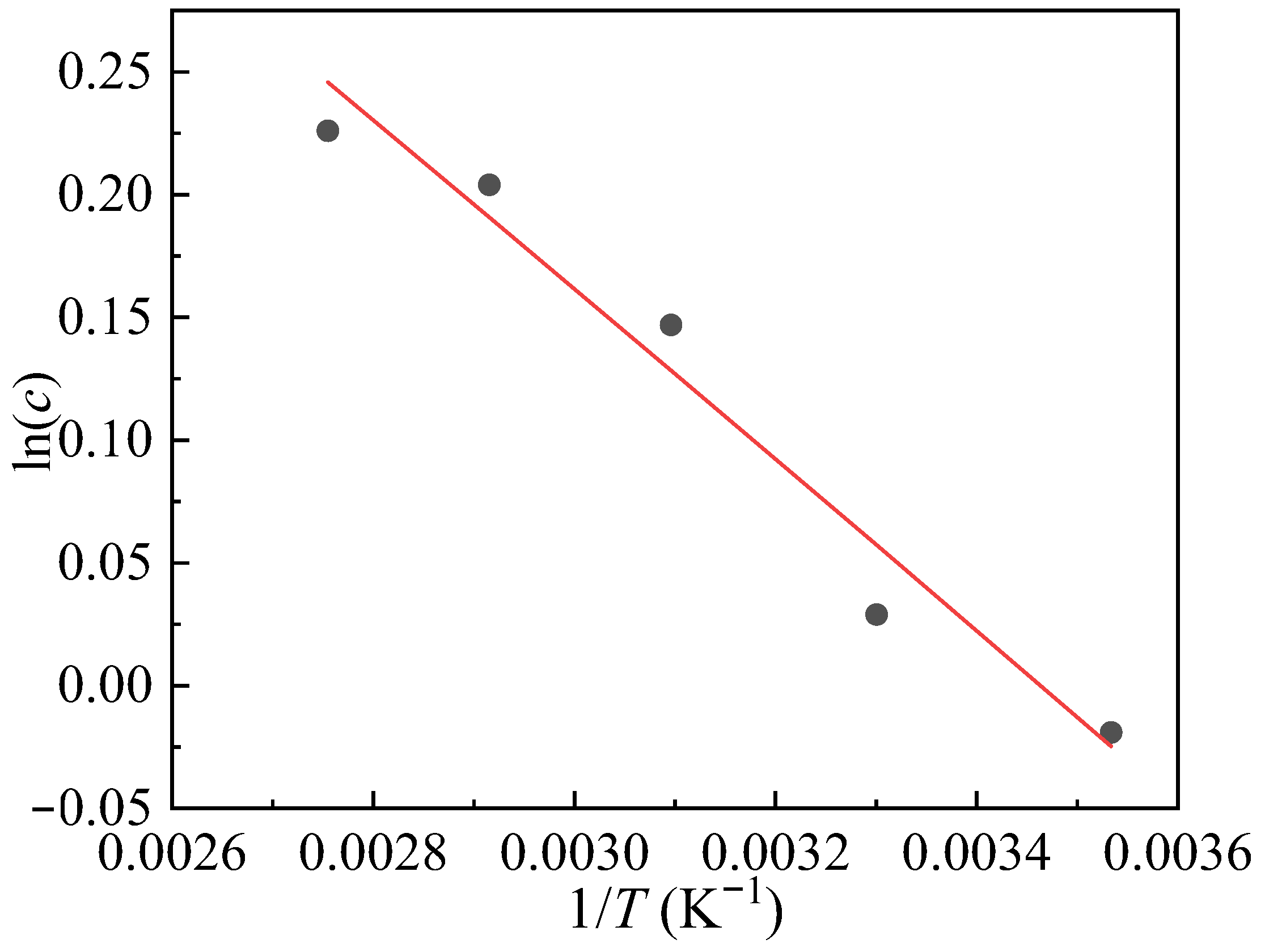
| Parameter | Value |
|---|---|
| Material | 60Si2CrVA |
| Free Height (mm) | 380 |
| Wire Diameter (mm) | 22 |
| Active Coils | 7.5 |
| Total Coils | 9.5 |
| Maximum Compression (mm) | 135 |
| Standard Working Height (mm) | H1 = 347, H2 = 245 |
| Closing Time (ms) | 50–80 |
| Operating Temperature | −30 °C–70 °C |
| Temperature (°C) | Regression Equation | Rate of Stress Loss (k) | Coefficient of Determination (r2) |
|---|---|---|---|
| −10 | 0.563 | 0.983 | |
| 10 | 0.569 | 0.990 | |
| 30 | 0.571 | 0.987 | |
| 50 | 0.592 | 0.986 | |
| 70 | 0.741 | 0.995 | |
| 90 | 0.958 | 0.988 | |
| 110 | 0.957 | 0.921 |
Disclaimer/Publisher’s Note: The statements, opinions and data contained in all publications are solely those of the individual author(s) and contributor(s) and not of MDPI and/or the editor(s). MDPI and/or the editor(s) disclaim responsibility for any injury to people or property resulting from any ideas, methods, instructions or products referred to in the content. |
© 2025 by the authors. Licensee MDPI, Basel, Switzerland. This article is an open access article distributed under the terms and conditions of the Creative Commons Attribution (CC BY) license (https://creativecommons.org/licenses/by/4.0/).
Share and Cite
Yang, M.; Wei, L.; Qiu, P.; Hu, G.; Yang, K.; He, X.; Peng, Z.; Zhou, F.; Zhang, Y.; Luo, J.; et al. Evaluation on the Long-Term Operational Reliability of Closing Springs in High-Voltage Circuit Breakers. Energies 2025, 18, 1806. https://doi.org/10.3390/en18071806
Yang M, Wei L, Qiu P, Hu G, Yang K, He X, Peng Z, Zhou F, Zhang Y, Luo J, et al. Evaluation on the Long-Term Operational Reliability of Closing Springs in High-Voltage Circuit Breakers. Energies. 2025; 18(7):1806. https://doi.org/10.3390/en18071806
Chicago/Turabian StyleYang, Mingkun, Liangliang Wei, Pengfeng Qiu, Guangfu Hu, Kun Yang, Xiaohui He, Zhaoyu Peng, Fangrong Zhou, Yun Zhang, Jie Luo, and et al. 2025. "Evaluation on the Long-Term Operational Reliability of Closing Springs in High-Voltage Circuit Breakers" Energies 18, no. 7: 1806. https://doi.org/10.3390/en18071806
APA StyleYang, M., Wei, L., Qiu, P., Hu, G., Yang, K., He, X., Peng, Z., Zhou, F., Zhang, Y., Luo, J., & Zhao, X. (2025). Evaluation on the Long-Term Operational Reliability of Closing Springs in High-Voltage Circuit Breakers. Energies, 18(7), 1806. https://doi.org/10.3390/en18071806






